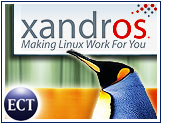
Xandros, which makes intuitive Linux solutions and tools to manage mixed environments, announced two new products that will make it easier for Windows systems administrators to manage Linux platforms in their IT environment.
One is the Xandros BridgeWays Management Console for Red Hat Enterprise Linux. The other is Opsi4xandros, an all-in-one solution developed jointly with Opsi.org, which provides Linux-based tools for maintaining Windows workstations.
The two were announced at CeBIT 2008, being held in Hannover, Germany.
Windows Bridge
The products will prove useful as Linux increasingly penetrates the enterprise, the company said.
“Generally speaking, people who administer Windows environments aren’t as comfortable working at the text file level, which is more characteristic of Linux, and giving them a graphical interface to manage Linux is a huge win,” open source expert Bernard Golden, CEO of Navica, told LinuxInsider. “It makes it easier for those organizations to adopt Linux.”
The Xandros BridgeWays Management Console for Red Hat offers graphical administration of Red Hat servers to Windows system administrators who have no experience with Linux.
It uses a version of the workflow automation technology that was developed for the Xandros Server, adapted for administering servers running 32- and 64-bit versions of Red Hat Enterprise Linux 4.6 or 5.1.
Command Module
The console integrates multiple Red Hat servers and services into a single managed community that can be remotely administered from supported Red Hat servers, or from any Windows XP or Vista desktop.
It enables centralized user management, system monitoring and event viewing. Services support includes high availability and load balancing clustering, DHCP (Dynamic Host Configuration Protocol), DNS (Domain Name System), file, firewall, FTP (file transfer protocol), print, proxy, routing, Security-Enhanced Linux (SELinux), SSH (Secure Shell), storage manager, virtual machine manager, Web and Windows networking.
The other tool, Opsi4xandros, lets Windows system administrators who have no Linux experience deploy and maintain Windows service packs and security updates on client PCs, and update signature files for antivirus software. It also lets them maintain centralized hardware and software inventories.
Opsi, which has been in production use for the past 10 years, provides a tool for remotely installing operating systems and deploying software. It is based on a Linux server but its primary targets are Windows workstations.
Linux Gains in the Enterprise
The Linux ecosystem, worth around US$18 billion last year, will be worth $40 billion by 2010, according to research firm IDC.
That ecosystem consists of deployment, integration and consulting, and there is a lot of integration of Linux into enterprise IT environments, IDC said.
“A lot of enterprises have moved to Linux because they’re moving off Unix and they find Linux lets them maintain their skills but move to lower-cost hardware — x86 boxes instead of Sun or HP Unix boxes,” Golden said.
HP is one of the leaders in the Linux server market. “HP’s philosophy is, ‘if you’re going to move off Unix boxes, why don’t you stay in the family and move to an HP Linux box?’ They sell a ton of x86 hardware that Linux runs on,” Golden added.




















































